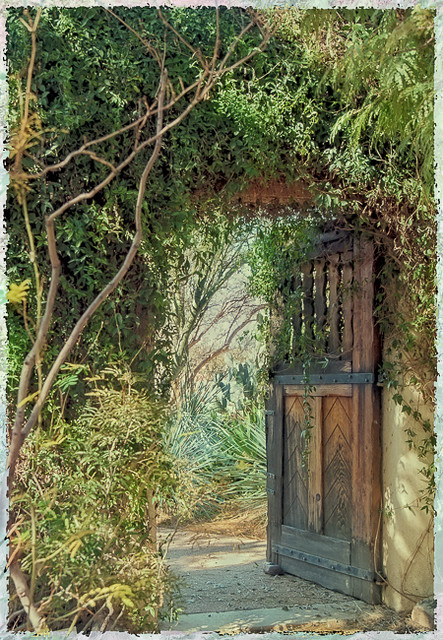Our spiritual energy needs to be renewed each day. Our soul needs to be uplifted, and our wounded or tired spirit needs periodic regeneration. Finding sanctuary in a lovely and peaceful garden setting – one that seems to enfold the soul in magic, celebration, art, curiosity, and contemplation – can do the job. ~ Christopher McDowell
A sanctuary is a sacred space.
The word sanctuary comes from the Latin word sanctum which means a place of sacrosanct privacy. When we create the space especially for our personal use, we give ourselves permission to take time from our hectic day and retreat into the quiet, to enter a place of slowing down, a rejuvenating space for body, mind, and soul.
A garden sanctuary can take many forms.
It can be a space with a strolling path, flowers, shade trees, a bench; a chair next to a tree or garden plot; a balcony with a flower box; even a potted plant near a window in your home. In the desert, a garden sanctuary can be as simple as a shaded space offering protection from the sun with a view of ground hugging succulents or the raw beauty of the desert colors.
My garden sanctuary is an arroyo, rocky and dry, with prickly pear cacti, chain fruit cholla, and palo verde trees.
At dawn and dusk the trees shimmer with birds – orioles, cactus wrens, hummingbirds, cardinals. Road runners and quail hurry along the edge of the arroyo a few paces from where I sit. There, I reclaim my spirit surrounded by the sacred.
Within you there is a stillness and a sanctuary to which you can retreat at any time and be yourself.
~ Herman Hesse
SANCTUARY offers these suggestions for contemplation:
- Combine a quiet space and nature and you create a sanctuary garden. A place where the busyness of the world can spin without you. A place for contemplation of the simple things, of the beauty of life. A place to renew your energy. A place to practice reverence and gratitude. Can a place be all those things? Make it your intention. Embrace the sacredness of you and your space, and your sanctuary will be the retreat you envision.
- Thomas Moore writes in his book, The Re-enchantment of Everyday Life, “Entering a garden is like passing through a mystical gate. Things are not the same on the other side.” Visualize your passage through a garden gate, perhaps after a busy or stress-filled day. What do you see in your mind’s eye that is soothing, uplifting, rejuvenating, or inspirational?
- Begin a sanctuary practice with a ritual to mark the transition from frenetic activity to reverential pause. The ritual can be simple – preparing and enjoying a cup of aromatic herbal tea, repeating a favorite mantra, holding a smooth stone. Choose something meaningful to you.
- Create a simple book, a few pieces of paper folded together is sufficient, and make notations on your relationship with your sanctuary time weekly for several months. Limit yourself to one or two sentences. Notice how your story unfolds. Notice how your words reflect sanctuary. You are your garden’s story keeper, the container of your sanctuary.











